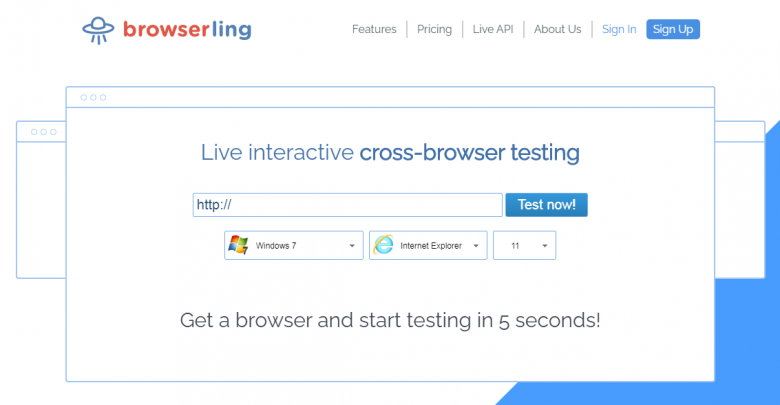
Browserstack is a cross browser and app testing tool for web developers and designers. It provides virtual machines that run in the cloud and provide an environment for real cross-browser testing. Testing is an important task to make sure your project is built right and is ready for production. Bugs in production are costly and debugging production code takes more time than carefully designing everything from the start. To make development time faster and reduce production bugs, developers can use various tools, automation scripts, and special testing environments. Cross-browser testing is one of such methods and it enables developers to test web project in various platforms and browsers before hitting production.
The main feature I would like to focus on in this post is cross-browser testing and Browserstack does a really great job at this task. It provides the latest browsers in virtual machines and keeps the browsers updated. However, it’s not the only cross-browser testing platform, and in this post we’ll take a look at other cross-browser testing tools and see how they compare to Browserstack. For example, Browserstack has a short time limit for the free users but other platforms give more time. Also, there are differences between various developer and team plans. So let’s see what we have as alternatives and which ones are the best for cross-browser testing.
1. Browserling

Browserling is a great Browserstack alternative. It provides cross-browsing tests with tons of browser combinations including operating systems you won’t find in other alternatives in this list (such as Linux and ReactOS). I have put them as the top alternative choice as they are in fact one of the first companies to offer a cross-browser testing service. The team is very skilled in what they do and provide and they have perfected solving cross-browser testing issues for over 10 years now. Companies like L’Oréal, PubNub, and Teespring use Browserling to test their projects. They can also provide custom solutions for your company, and they provide excellent support.
Pros
- All the browsers including mobile versions are genuine browsers running in VMs.
- Basic plan includes local testing via SSH Tunnels which many alternatives fail to provide or only provide with enterprise plans.
- Browser extensions for Chrome, Firefox, Opera, and Safari with an Edge extension coming soon. I really love this feature because it is way faster to launch a test instances using the browser extension.
- And the best thing is, Browserling can provide you with custom solutions for any kind of requirement.
- Their website has tons of useful dev tools which you can use for various tasks. This extra benefit is surely nice and welcoming.
Cons
- Free plan is limited to only three minutes of time and you have to wait in a queue. You can only access Win 7 with IE.
- No screen-recording feature yet, but they are working to bring it along with headless API and screen sharing.
- Less polished bug hunting and marking tools. Also the on-screen keyboard looks tiny.
- No analytics insights.
2. Saucelabs

Saucelabs provides comprehensive cross-browser testing in virtual machines in the cloud. This can be a viable alternative to Browserstack especially if you are an enterprise because of similarities in service level as well as SLA terms. Saucelabs has an array of browsers and operating systems to test your web projects.
Pros
- Supports the world’s largest continuous testing cloud that lets you focus on testing your apps while we staying up-to-date with the newest browsers and operating systems.
- Tests are run in parallel that are optimized to run across many different browser and OS combinations as you need. This can accelerate your test run time by up to 10x.
- You can play video recording of your entire test or flip through screen shots.
- The tests are recorded in selenium log files and the metadata is stored for each test. This makes it easy to share results with developer teams and speed up debugging.
- Extended debugger provides browser console logs and network calls to gain insight into network requests and browser performance that can cause automated tests to fail, helping to speed root cause analysis.
Cons
- No free plan – there is a limited trial for 28 days and then you have to upgrade to one of the premium plans.
- High price – the single user plan costs $29 a month (for virtual machines only), for real devices, you need to pay $60 – $88. For a team plan, you have to pay from $199 and up to several thousands of dollars.
- Time limitation – even if you upgrade to a paid plan, there is a time limitation.
Saucelabs is a good alternative if you have a larger organization or team with enough money for their pricey plans. If you can pay, you have more than Browserstack features including good availability of servers and features.
3. CrossBrowserTesting

Crossbrowsertesting by Smartbear provides a vast array of browser combinations and real mobile device testing platforms. You can live test, interact and visually test your web projects with Crossbrowsertesting. Crossbrowsertesting uses real mobile devices which is good compared to emulators used by Saucelabs. They also provide integration with lots of services.
Pros
- Nice UI with WebRTC and HTML5 viewer for test instances.
- Real mobile devices instead of emulators and simulators.
- Local and staged testing for your local projects.
- Native debugging tools let you debug easily within the testing environment.
- Lots of operating system choices including MacOS and iOS.
Cons
- No extensions (there is only for Chrome): No browser extensions for quick launch, so you have to login to dashboard everytime.
- Relatively high launch time: Instances load slowly and you have to wait a bit for test instances to be prepared and launched.
- Limited integration: Many of the alternatives provide tons of integration options for many platforms. Currently CrossBrowserTesting only provides three integration options.
- Very limited trial: You have limited trial for 7 days before you sign up for premium plans.
- High price: Like previous alternatives, this also has pricing issues with the lowest $39 per month. There is a limited plan which costs $15, but that is as useless as a trial account.
Crossbrowser is simple to use compared to Saucelabs. Although there is no analytic tool and good integration options. CBT is very simple to use, and I like the interface for viewers which supports both HTML5 and WebRTC.
4. Testingbot

Testingbot lets you cross-browser test using various OS and browser choices. They provide options for Selenium, Appium and Cypress tests on the cloud and few other integration options. Testingbot also has performance and visual testing tools.
Pros
- 2600 browsers and devices – one of the hugest collection of browsers and devices, which you can instantly start using for live and automated testing.
- Includes Linux browsers that many other services don’t provide.
- Uses WebRTC to connect to a browser that provides very high speed connection without delays
- Integration with CI/CD, Slack, Jira, Selenium IDE and Katalon Studio.
- Automated tests using various frameworks in many languages including PHP, Ruby, Python, JS and more.
- 8 years of experience.
- Amazing analytics for test results.
Cons
- Time limits: Premium account has time limits.
- Strange pricing: Pricing is weird, generally more parallel tests should cost 2x the price, but it’s 3x the price.
- Uses simulator for mobile devices: Mobile devices are created inside virtualized operating systems instead of dedicated real mobile OS.
- Many features including local testing are only available in Enterprise plan.
Basic plans for Testingbot are enough for cross-browser testing. Customizing VM and more security options are available for enterprise users. You can easily invite other Testingbot members in your team, or you can add by emails. Members with read only access can be added.
5. Ghostlab

Ghostlab is a web development and responsive testing and inspection tool. It runs on Windows and MacOS provides tools for synchronized testing and inspection. All of your browser actions will reflect onto other browsers added to it. Inspections and DOM modifications will also get synced across all browsers. It’s designed for web developers, testers, agencies, freelancers, and anyone wanting to test or develop a website, it is an on-premise solution for local testing.
Pros
- Test projects simultaneously, synchronized across all browsers and devices.
- Built-in CSS inspector.
- Haml, Pug (Jade), Sass, Less, Stylus, TypeScript and CoffeeScript inspection support.
- Remote screenshots.
- One-time payment.
Cons
- Local only: You can only select a handful of browsers because you are installing them locally.
- Setting up is tedious: Since you have to set up every browser yourself, it consumes tons of time and costs a lot of effort. You will find yourself setting each device and browsers for a long time.
- Pricing per user: While Ghostlab is available for one-time payment, but when you need more than one host device and user, you have to buy a license for each one.
- No Linux support: Supports Windows and Mac but not Linux.
- No Cloud: You cannot deploy it to cloud.
This is a good alternative to Browserstack and I have included it for those who need local cross-browser tests and don’t want to commit to recurring payments.
Conclusion
Many people use Browserstack for cross-browser testing which is very costly. There are many reasons people want to search for alternatives. In this list, you will find top 5 alternatives for Browserstack. I have tried to include options for everyone from feature-rich to affordable alternatives for those who are finding viable alternatives to Browserstack. Thank you so much for reading.




